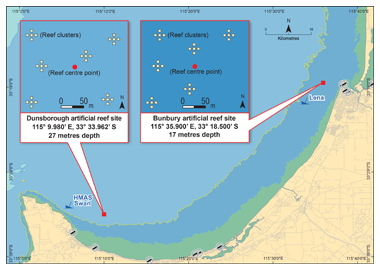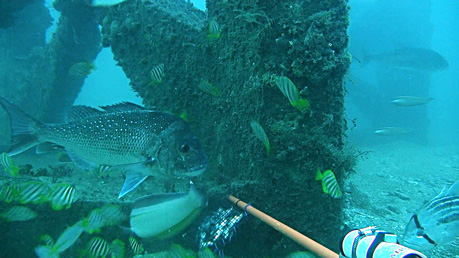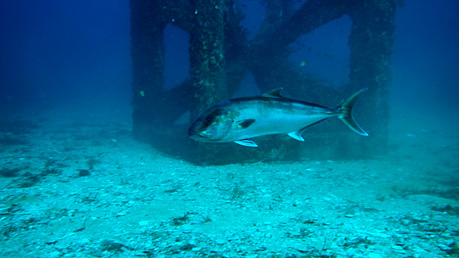Fish aggregating devices (FADs)
The State Government has invested $1.5 million over 3 years to expand the FADs program as part of the support package for the recovery of the West Coast Demersal Scalefish Resource. This follows the successful four-year trial by Recfishwest through the Recreational Fishing Initiatives Fund.
The program is currently managed by the Department of Primary Industries and Regional Development and provides exciting sport fishing opportunities for recreational fishers.
FADs are deployed (and retrieved) from Broome to Albany. This season, we have added new echosounder buoys and baited cameras to a selection of southern WA FADs. These additions will help us improve our ability to better understand the fish species attracted to them, and over time improve the network of FADs for recreational fishers.
FADs consist of buoys or floats that are moored to the ocean floor using an anchor system. The primary function of a FAD is to attract baitfish which use the FAD as shelter and attract pelagic fish such as mahi-mahi, tuna, and marlin.
Fishing off FADs provides recreational fishers with the opportunity to 'switch their fish' and target pelagic species to give fish such as pink snapper and dhufish a break and the opportunity to recover.
FAD locations
FADs have been deployed at the following locations.
| 01 |
North Metro
|
31-37.277 S, 115-07.997 E |
| 02 |
North Metro
|
31-41.716 S, 115-08.008 E |
| 03 |
North Metro
(inactive) |
31-42.0204 S, 115-10.5124 E |
| 04 |
North Metro
|
31-43.720 S, 115-10.524 E |
| 05 |
Woodman Pt
(inactive) |
32-7.146 S, 115-7.157 E |
| 06 |
Woodman Pt |
32-06.780 S, 115.10.065 E |
| 07 |
Rockingham
|
32-17.559 S, 115-5.63598 E |
| 08 |
Rockingham
|
32-14.8760 S, 115-07.3000 E |
| 09 |
Mandurah
|
32-31.5600 S, 115-04.2000 E |
| 10 |
Mandurah
|
32-33.2525 S, 115-3.4038 E |
| 11 |
Lancelin
|
31-16.566 S, 115-01.629 E |
| 12 |
Lancelin
|
31-03.947 S, 114-52.463 E |
| 13 |
Jurien
(inactive) |
30-1.56876 S, 114-30.12306 E |
| 14 |
Jurien
|
30-13.466 S, 114-34.415 E |
| 15 |
Jurien
|
30-16.7 S, 114-34.873 E |
| 16 |
Jurien
|
30-29.330 S, 114-37.559 E |
| 29 |
Jurien
|
30-18.49272 S, 114-35.30148 E |
| 17 |
Steep Pt
|
26-10.353 S, 113-2.188 E |
| 18 |
Steep Pt
(inactive) |
26-6.378 S, 113-6.336 E |
| 19 |
Leeman
|
30-00.228 S, 114-29.579 E |
| 21 |
Albany (inactive)
|
35-18.796 S, 118-1.906 E |
| 22 |
Albany
|
35-18.709 S, 118-5.422 E |
| 23 |
Albany
|
35-22.4658 S, 118-7.59 E |
| 24 |
Albany
|
35-23.391 S, 118-5.5656 E |
| 25 |
Cape Naturaliste
(inactive) |
33-16.575 S, 114-32.648 E |
| 26 |
Cape Naturaliste
|
33-18.991 S, 114-41.797 E |
| 27 |
Cape Naturaliste
|
33-15.78978 S, 114-34.9365 E |
| 28 |
Cape Naturaliste
|
33-18.61572 S, 114-39.43062 E |
| 30 |
Abrolhos
(inactive) |
28-59.003 S, 113-46.884 E |
| 31 |
Abrolhos
(inactive) |
28-49.656 S, 113-39.923 E |
| 32 |
Abrolhos
(inactive) |
28-52.7418 S, 113-42.366 E |
| 33 |
Exmouth
|
21-36.110 S, 114-01.230 E |
| 34 |
Exmouth
|
21-35.852 S, 114-06.751 E |
| 35 |
Exmouth |
21-38.001 S, 114-03.255 E |
| 36 |
Exmouth |
21-38.108 S, 114-05.826 E |
| 37 |
Broome
(retrieved) |
17-54.369 S, 121-45.595 E |
| 38 |
Broome
(retrieved) |
17-56.928 S, 121-34.420 E |
| 39 |
Broome
(retrieved) |
17-48.709 S, 121-39.364 E |
| 40 |
Broome
(retrieved) |
17-46.011 S, 121-34.626 E |
| 41 |
Dampier
(retrieved) |
20-20.494 S, 116-15.299 E |
| 42 |
Dampier |
20-17.044 S, 117-7.873 E |
| 43 |
Dampier |
20-24.464 S, 116-23.999 E |
Artificial reefs
Artificial reefs are designed to enhance recreational fishing opportunities by providing additional habitat for fish and other aquatic organisms, increasing their numbers in the area.
The reefs come in many different sizes, shapes and models, for example some are tower-like steel structures whereas others are cube-shaped, constructed from reinforced concrete. Once installed on the ocean floor the reef structures begin to be populated by aquatic life, attracting more organisms and fish, and a food web begins to develop.
South West artificial reefs trial project
In 2013, in collaboration with Recfishwest, we installed  two artificial reefs on the seabed off Dunsborough and Bunbury as part of our South West Artificial Reefs Trial Project.
two artificial reefs on the seabed off Dunsborough and Bunbury as part of our South West Artificial Reefs Trial Project.

Click on the map above to view a  larger version.
larger version.
The $2.38 million project is the first purpose-built recreational fishing artificial reef trial of its kind in Western Australia and includes four-year funding for a comprehensive scientific monitoring program closely observing the reefs’ ecological development.
Each artificial reef is made up of 30 ten-tonne reinforced concrete modules placed in six clusters in the four-hectare reef area and provides suitable habitats for a wide range of species.
This ‘fish cube’ design used for the reef modules has been established specifically to enhance recreational fishing opportunities for the project’s ‘target species’ – pink snapper, silver (skipjack) trevally and Samson fish.
Our researchers are carrying out a comprehensive monitoring program of the South West artificial reefs to assess their biological and ecological aspects.

Some of the fish species found on or around the artificial reefs including pink snapper, West Australian dhufish and Samson fish (in the background).
Community benefits
The reefs are proving popular among locals and visitors fishing in Geographe Bay with plenty of reports of good catches from over and around the reefs. As well as enhancing recreational fishing opportunities for locals and tourists, the initiative is benefiting local businesses connected to recreational angling, boating and accommodation.
Each artificial reef project is being funded through recreational fishing licence fees as part of the Recreational Fishing Initiatives Fund, with the South West project also receiving funding from the Royalties for Regions program ($1.86 million).
The recreational fishing community is also getting involved – Recfishwest have set up a dedicated Facebook page for recreational fishers to share their fishing experiences on the reefs.

A Samson fish swims by one of the artificial reef modules in Geographe Bay.
Other artificial reefs projects
In addition to the South West Artificial Reefs Trial Project, another two artificial reef projects are being progressed by Recfishwest, with one installed off Mandurah in April 2016 and two 'artificial reef towers' installed south of Rottnest Island in December 2016.